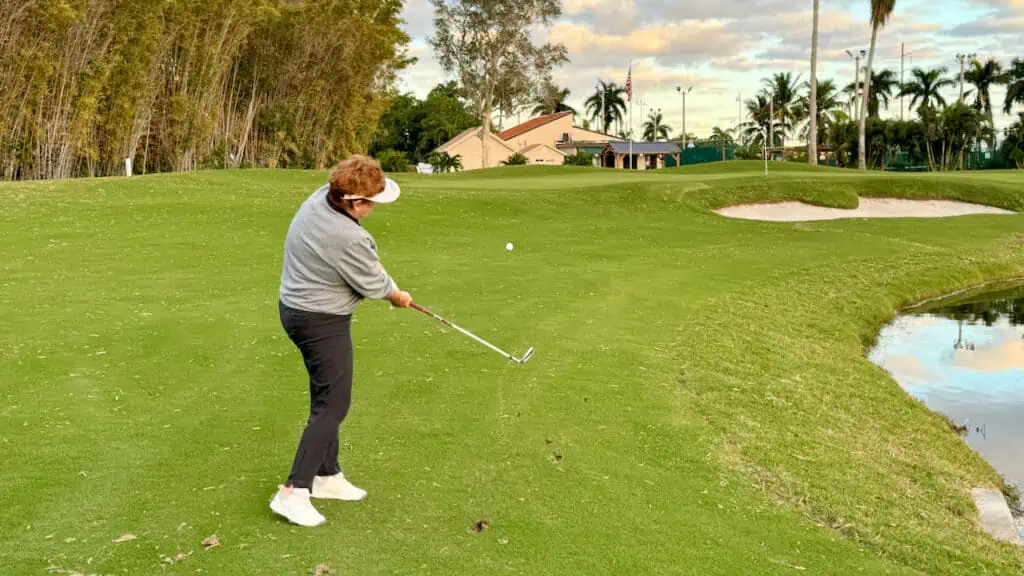Table of Contents
Golf course management for high handicappers is a crucial aspect of the game that oftentimes goes unnoticed.
Yet, it holds the key to unlocking lower scores and a more enjoyable experience on the golf course.
Like Chess…You Can Learn Golf Strategy
In chess, every move counts, and a single misstep can lead to defeat.
Golf shares this strategic path. A poorly planned approach or an ill-chosen club can easily add strokes to your score or hand the advantage to your opponent in tournament play.
Golf course management revolves around using strategic thinking, much like a chess player, to make smarter decisions during play.
11 Golf Course Management Tips for High Handicappers

As a seasoned golfer, I am always looking for good golf tips or ideas to improve my score. With 50+ years of golf under my belt, I’ve tried about everything on the course!
So, I developed a set of golf course management tips, which have consistently helped me navigate the complexities of various golf courses.
To save you time (and hopefully a few strokes), here are my top 11 strategies for effective golf course management for high handicappers.
1. Position Yourself for Success on the Tee Box
On the tee box, your initial position can be a pivotal decision, especially when facing course hazards.
For instance, imagine a scenario with a water hazard along the right side of the fairway. A better move is to tee your ball up on the right side near the tee marker.
This positioning naturally aims your drive away from the water, significantly reducing the risk of finding yourself in trouble. It’s a strategic approach that (ideally) avoids the immediate hazard and sets you up for a more favorable angle on your next shot.
2. Determine Pin Placement Before You Swing

Before hitting your shot from the tee, a critical step is to observe the pin’s placement on the green. This knowledge is invaluable in determining where to place your drive in the fairway.
For example, if the pin is on the left, aim your shot to the right side of the fairway and vice versa.
This strategic placement simplifies your approach shot and gives you a better angle to the pin, reducing the challenge of navigating potential hazards or tricky green contours. This foresight can make a challenging approach more manageable.
3. Know What Lies Beyond the Green

Another vital aspect of golf course management for high handicappers is being aware of the area behind the green before your approach shot.
Check for bunkers, water hazards, or rough terrain to avoid overshooting the green and end up in worse shape.
Choosing a club that helps you avoid these areas is crucial. It’s better to be cautious and stay on the green than face a challenging recovery from a hazard.
4. Opt for Putting Over Chipping
Where I play golf in Florida, the area around the green is often very tight, meaning there’s minimal grass under the ball.
Choosing to use a putter from off the green can be more effective than chipping with a wedge. This decision can lead to greater accuracy and control, particularly when the grass is too sparse for a confident chip shot.
Putting the golf ball in these conditions helps to avoid the risk of ”chunk” shots, where the club digs into the turf and ensures a smoother path to the hole.
For beginner players, this approach can be a practical solution to a common challenge, enhancing the likelihood of a successful up-and-down.
5. Strategic Positioning on Par Fives
On a par five, the placement of your second shot is critical. The goal is to set yourself up for a clear and unobstructed third shot towards the green.
Plan your second shot in a way that positions you advantageously, keeping clear of hazards and trouble spots. This might mean favoring a side of the fairway that offers a more open approach or staying away from areas that could complicate your next shot.
This thought-out positioning can make a significant difference for beginners, turning a challenging par five into an opportunity for a solid score.
6. Handling Trouble Shots Wisely

Encountering trouble spots, like being in bunkers, is a common challenge on the course. In such situations, the best approach is often the most pragmatic one. This means, “Take your medicine.”
Instead of attempting a high-risk shot, opt for a safer ”punch out” to move the ball back into play.
While it may feel like conceding, this golf strategy avoids the potential for even greater trouble and keeps your scorecard from suffering unnecessary damage. Acknowledging when to play it safe is a key aspect of smart golf course management.
⛳️ Read Next: Losing Distance with Your Golf Irons? Here’s Why
7. Resist the Temptation to Always “Go for It”
The allure of reaching the green in one daring shot is strong, but it’s not always the wisest choice.
Assess each situation carefully. If there are hazards like water or reachable bunkers between you and the green, consider playing a shorter, safer shot instead.
This conservative approach might mean hitting short of the hazard and then approaching the green with your next shot. Adopting this mindset reduces the risk of double or triple bogeys. Remember, sometimes the best offense in golf is a well-played defense.
8. Consider the Consequences
Reflect on the potential outcomes before deciding on your shot. I recall a round with my son-in-law where this lesson came into play.
His tee shot on a par four ended up in deep grass near the water’s edge. His initial plan was ambitious: to hit the ball out of the rough, clear a few trees, and land it short of the green.
At first, I didn’t say anything to him as he started to flail away. After a couple of tries, he realized that his plan was not going to work. I told him to punch the ball into the fairway instead, where he had a clear shot to the green. Of course, he answered, “Why didn’t you tell me that in the first place? Go figure!

9. Finding Your Balance: Confident Golf Swing + Conservative Play = Better Scores
There’s an essential balance between playing conservatively and swinging with confidence.
The key is to be thoughtful and strategic in your overall game plan, choosing shots that avoid unnecessary risks. However, once you’ve made your decision, commit to it.
A tentative golf swing often leads to mistakes. While a bold, assertive swing, executed with a clear plan in mind, can yield better results.
10. Maintain Mental Resilience Through Your Golf Game

Golf is just as much a mental challenge as a physical one. Whether in a competitive amateur golf match or playing for leisure, encountering a ‘blow up’ hole is almost inevitable.
The key is not to let these setbacks derail your focus or disrupt your course management. Accept these moments with composure, learn from them, and then refocus on the next shot.
Maintaining a steady mental state helps you regain control and manage your game effectively. This resilience is particularly crucial for high handicappers, as it enables them to navigate the ups and downs of a round without losing confidence or strategy.
11. Utilize Your Favorite Yardage to Your Advantage
A less commonly known but effective tip is to find and use your favorite distance on the course. This is the yardage where you feel most confident and can hit with precision.
For instance, my go-to distance is 110 yards – not 100, not 120, but exactly 110 yards. At this distance, I can confidently use my 7 hybrid to place the ball exactly where I want it. I often use this tactic on par fives, laying up to my favorite distance for the best chance of a successful shot.
By identifying your favorite distance and aiming for it when the opportunity arises (especially in situations where you can lay up), you’ll find that your scoring can improve significantly.
It’s about playing to your strengths and making the course work for you.
Final Thoughts
I’ve learned a thing or two over the years, enduring my share of bad shots, and even golf slumps. While I don’t enjoy the downside of the game, I honestly think it would be boring if it were easy!
Beginners or high handicap golfers who develop a golf strategy will no doubt be more consistent than those who play off the cuff.
For those hungry for more advanced golf course management tips and tactics, our recent article by our golf pro is a worthwhile read. It offers strategies that prepare you for competitive golf.
Remember, golf is a lifelong journey – one filled with surprising shots and laughter-inducing mishits. Remember these golf tips, but most importantly, enjoy your time on the course.


